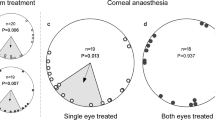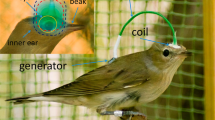Abstract
Magnetic compass information has a key role in bird orientation1,2,3, but the physiological mechanisms enabling birds to sense the Earth’s magnetic field remain one of the unresolved mysteries in biology2,4. Two biophysical mechanisms have become established as the most promising magnetodetection candidates. The iron-mineral-based hypothesis suggests that magnetic information is detected by magnetoreceptors in the upper beak and transmitted through the ophthalmic branch of the trigeminal nerve to the brain5,6,7,8,9,10. The light-dependent hypothesis suggests that magnetic field direction is sensed by radical pair-forming photopigments in the eyes11,12,13,14,15 and that this visual signal is processed in cluster N, a specialized, night-time active, light-processing forebrain region16,17,18,19. Here we report that European robins with bilateral lesions of cluster N are unable to show oriented magnetic-compass-guided behaviour but are able to perform sun compass and star compass orientation behaviour. In contrast, bilateral section of the ophthalmic branch of the trigeminal nerve in European robins did not influence the birds’ ability to use their magnetic compass for orientation. These data show that cluster N is required for magnetic compass orientation in this species and indicate that it may be specifically involved in processing of magnetic compass information. Furthermore, the data strongly suggest that a vision-mediated mechanism underlies the magnetic compass in this migratory songbird, and that the putative iron-mineral-based receptors in the upper beak connected to the brain by the trigeminal nerve6,7,8 are neither necessary nor sufficient for magnetic compass orientation in European robins.
This is a preview of subscription content, access via your institution
Access options
Subscribe to this journal
Receive 51 print issues and online access
$199.00 per year
only $3.90 per issue
Buy this article
- Purchase on Springer Link
- Instant access to full article PDF
Prices may be subject to local taxes which are calculated during checkout



Similar content being viewed by others
References
Wiltschko, W. & Wiltschko, R. Magnetic compass of European robins. Science 176, 62–64 (1972)
Wiltschko, W. & Wiltschko, R. Magnetic compass orientation in birds and its physiological basis. Naturwissenschaften 89, 445–452 (2002)
Cochran, W. W., Mouritsen, H. & Wikelski, M. Free-flying migrating songbirds recalibrate their magnetic compass daily from sunset cues. Science 304, 405–408 (2004)
Mouritsen, H. & Ritz, T. Magnetoreception and it use in bird navigation. Curr. Opin. Neurobiol. 15, 406–414 (2005)
Kirschvink, J. L. & Gould, J. L. Biogenic magnetite as a basis for magnetic field sensitivity in animals. Biosystems 13, 181–201 (1981)
Walker, M. M. et al. Structure and function of the vertebrate magnetic sense. Nature 390, 371–376 (1997)
Williams, N. M. & Wild, J. M. Trigeminally innervated iron-containing structures in the beak of homing pigeons, and other birds. Brain Res. 889, 243–246 (2001)
Fleissner, G. et al. Ultrastructural analysis of a putative magnetoreceptor in the beak of homing pigeons. J. Comp. Neurol. 458, 350–360 (2003)
Fleissner, G., Stahl, B., Thalau, P., Falkenberg, G. & Fleissner, G. A novel concept of Fe-mineral-based magnetoreception: histological and physicochemical data from the upper beak of homing pigeons. Naturwissenschaften 94, 631–642 (2007)
Mora, C. V., Davison, M., Wild, J. M. & Walker, M. M. Magnetoreception and its trigeminal mediation in the homing pigeon. Nature 432, 508–511 (2004)
Ritz, T., Adem, S. & Schulten, K. A model for photoreceptor-based magnetoreception in birds. Biophys. J. 78, 707–718 (2000)
Ritz, T., Thalau, P., Phillips, J. B., Wiltschko, R. & Wiltschko, W. Resonance effects indicate radical pair mechanism for avian magnetic compass. Nature 429, 177–180 (2004)
Mouritsen, H. et al. Cryptochromes and activity markers co-localize in bird retina during magnetic orientation. Proc. Natl Acad. Sci. USA 101, 14294–14299 (2004)
Liedvogel, M. et al. Chemical magnetoreception: bird cryptochrome 1a is excited by blue light and forms long-lived radical-pairs. PLoS ONE 2, e1106 (2007)
Ritz, T. et al. Magnetic compass of birds is based on a molecule with optimal directional sensitivity. Biophys. J. 96, 3451–3457 (2009)
Mouritsen, H., Feenders, G., Liedvogel, M., Wada, K. & Jarvis, E. D. A night vision brain area in migratory songbirds. Proc. Natl Acad. Sci. USA 102, 8339–8344 (2005)
Liedvogel, M. et al. Lateralised activation of cluster N in the brains of migratory songbirds. Eur. J. Neurosci. 25, 1166–1173 (2007)
Heyers, D., Manns, M., Luksch, H., Güntürkün, O. & Mouritsen, H. A visual pathway links brain structures active during magnetic compass orientation in migratory birds. PLoS ONE 2, e937 (2007)
Feenders, G. et al. Molecular mapping of movement-associated areas in the avian brain: a motor theory for vocal learning origin. PLoS ONE 3, e1768 (2008)
Emlen, S. T. & Emlen, J. T. A technique for recording migratory orientation of captive birds. Auk 83, 361–367 (1966)
Mouritsen, H., Feenders, G., Hegemann, A. & Liedvogel, M. Thermal paper can replace typewriter correction paper in Emlen funnels. J. Ornithol. 150, 713–715 (2009)
Barami, K., Iversen, K., Furneaux, H. & Goldman, S. A. Hu protein as an early marker of neuronal phenotypic differentiation by subependymal zone cells of the adult songbird forebrain. J. Neurobiol. 28, 82–101 (1995)
Pasternak, T. & Hodos, W. Intensity difference thresholds after lesions of the visual Wulst in pigeons. J. Comp. Physiol. Psychol. 91, 485–497 (1977)
Åkesson, S. & Sandberg, R. Migratory orientation of passerines at dusk, night and dawn. Ethology 98, 177–191 (1994)
Beason, R. & Semm, P. Does the avian ophthalmic nerve carry magnetic navigational information? J. Exp. Biol. 199, 1241–1244 (1996)
Presti, D. & Pettigrew, J. D. Ferromagnetic coupling to muscle receptors as a basis for geomagnetic field sensitivity in animals. Nature 285, 99–101 (1980)
Dennis, T. E., Raynor, M. J. & Walker, M. M. Evidence that pigeons orient to geomagnetic intensity during homing. Proc. R. Soc. B 274, 1153–1158 (2007)
Gagliardo, A., Ioale, P., Savini, M. & Wild, J. M. Having the nerve to home: olfactory versus magnetoreceptor mediation of homing in pigeons. J. Exp. Biol. 209, 2888–2892 (2006)
Gagliardo, A., Ioalè, P., Savini, M. & Wild, J. M. Navigational abilities of homing pigeons deprived of olfactory or trigeminally mediated magnetic information when young. J. Exp. Biol. 211, 2046–2051 (2008)
Kirschvink, J. L. Uniform magnetic fields and double-wrapped coil systems: improved techniques for the design of bioelectromagnetic experiments. Bioelectromagnetics 13, 401–411 (1992)
Acknowledgements
We thank M. Bourdonnais, D. Hugo, A. Kittel, C. Mora and several volunteer students for assistance, E. Jarvis for scientific discussions, Blumberg GmbH, Rattingen, Germany for providing the thermal paper, the workshops of the University of Oldenburg for building huts, magnetic coil systems and electronic controls and J. Rahn for assistance in the planetarium of the Fachhochschule Oldenburg/Elsfleth. Financial support was provided by the Volkswagenstiftung (to H.M. and D.H.) and by the Deutsche Forschungsgemeinschaft (to H.M.).
Author Contributions H.M. designed and supervised the study. M.Z., C.M.H., S.E. and J.H. performed and M.Z. and C.M.H. supervised the majority of the orientation experiments. M.Z., C.M.H., S.E., J.H. and H.M. analysed the orientation results. J.M.W. and D.H. performed the surgeries. D.H. did the post-mortem histological analyses. D.D. performed the lesion analyses using AMIRA. S.W. and D.K. performed and analysed the operant conditioning. N.-L.S. suggested and made crucial improvements to the experimental set-up. H.M., M.Z., J.M.W. and D.H. wrote most of the paper. All authors read and commented on the manuscript.
Author information
Authors and Affiliations
Corresponding author
Supplementary information
Supplementary Figures
This file contains Supplementary Figures S1-S2 with Legends. (PDF 635 kb)
Rights and permissions
About this article
Cite this article
Zapka, M., Heyers, D., Hein, C. et al. Visual but not trigeminal mediation of magnetic compass information in a migratory bird . Nature 461, 1274–1277 (2009). https://doi.org/10.1038/nature08528
Received:
Accepted:
Issue Date:
DOI: https://doi.org/10.1038/nature08528
This article is cited by
-
Avian migration clocks in a changing world
Journal of Comparative Physiology A (2024)
-
No evidence for magnetic field effects on the behaviour of Drosophila
Nature (2023)
-
The Relationship between the Magnetic Compass and Vision in Birds: In Search of Receptor Cells
Neuroscience and Behavioral Physiology (2023)
-
Prussian blue technique is prone to yield false negative results in magnetoreception research
Scientific Reports (2022)
-
Morphology, biochemistry and connectivity of Cluster N and the hippocampal formation in a migratory bird
Brain Structure and Function (2022)
Comments
By submitting a comment you agree to abide by our Terms and Community Guidelines. If you find something abusive or that does not comply with our terms or guidelines please flag it as inappropriate.



